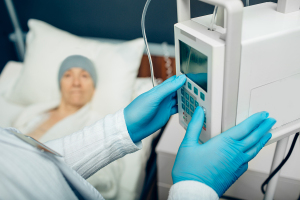Patients with COVID-19 and cancer more than twice as likely to die
by
John R. Fischer, Senior Reporter | June 02, 2020

Cancer patients with COVID-19 are more than twice as likely to succumb to the virus than all COVID-19 patients together.
Cancer patients diagnosed with COVID-19 face a 13% chance of death, according to a study by the COVID-19 and Cancer Consortium (CCC19), a multinational initiative.
Derived from information on more than 900 patients, the risk of death for those with cancer is more than twice that for all COVID-19 patients, according to the findings which are the first report in what is an ongoing international initiative to track outcomes during the pandemic among such patients.
“People with cancer face a great deal of uncertainty in the era of COVID-19, including whether the balance of risks and benefits in the treatment of cancer has shifted in some fundamental way,” said Dr. Jeremy Warner, associate professor of medicine and biomedical informatics at Vanderbilt University, the study’s corresponding author, in a statement. “The death rate for this group of patients as a whole was 13%, more than twice that reported for all patients with COVID-19 (by the Johns Hopkins Center for Systems Science and Engineering).
The report was compiled of data on 928 patients in Spain, Canada and the U.S. The data was recorded in the CCC19 registry, which was built and is maintained as an electronic REDCap database at Vanderbilt University Medical Center.
Certain subgroups, such as those with active (measurable) cancer, particularly progressive cancers, were more likely to fare worse, as data showed cancer-specific factors to be connected to increased mortality.
One of these factors was an ECOG performance status of two or worse. Patients who score two are considered to be capable of self-care but are unable to work, and are up and about more than 50% during waking hours. The number of comorbidities also increased chances of mortality, particularly the presence of two or more, such as hypertension and diabetes.
Patients younger than 65 had a mortality rate of 6%, while those between 65 and 74 had a 11% chance, and those older than 75, a 25% chance. Death occurred among 17% of males, compared to 9% of females.
Early data, however, did show no statistical association between 30-day mortality and cancer treatments. This suggests that surgery, adjuvant chemotherapy and maintenance chemotherapy could continue during the pandemic with “extreme caution.”
“While older patients and those with major comorbid conditions are at substantially increased risk of dying from COVID-19, our early findings are encouraging news for patients without major medical conditions who receive their cancer therapy within four weeks of their infection,” said Dr. Nicole Kuderer, of the Advanced Cancer Research Group in Seattle, one of the study’s lead authors, in a statement. “However, more data are needed to reliably assess individual higher risk therapies.”
Other lead authors include Dr. Toni Choueiri, the Jerome and Nancy Kohlberg Chair and professor of medicine at Harvard Medical School and director of the lank center for GU Oncology at Dana-Farber Cancer Institute; Dimpy Shah, Ph.D., MBBS, MSPH, assistant professor of epidemiology and biostatistics at Mays Cancer Center; and Yu Shyr, Ph.D., the Harold L. Moses Chair in Cancer Research and chair of the department of biostatistics at Vanderbilt.
Participants of CCC19 include members of the European Society of Medical Oncology (ESMO), institutions that are National Cancer Institute Designated Cancer Centers, researchers from several nations as well as community-based oncologists within the United States.
The findings were published in The Lancet and presented at ASCO Virtual.
|
|
|
You Must Be Logged In To Post A Comment
|
